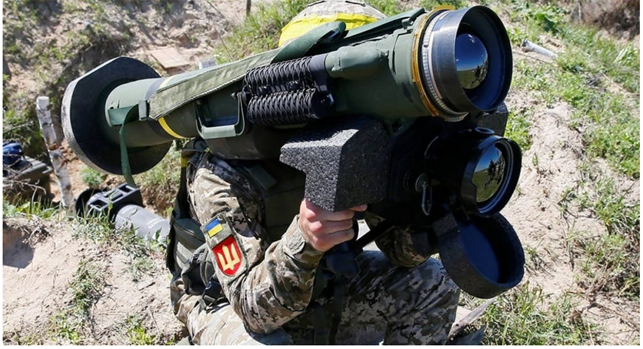
But one military analyst specializing in Eastern Europe said Ukraine’s aims were likely more modest.
Former Navy SEAL Charles Pfarrer said that the current efforts appeared to be aimed at softening and isolating the Russian forces in Kherson to force Russian commanders into a difficult position: attempt to hold territory with little hope for relief or reinforcement or plot an exit before it’s too late.
“Ukraine has managed to cut every river crossing between Kherson and Nova Kakhovka. That is constricting the lines of communication and supply to those north bank forces,” Pfarrer said.
The United States continues to supply Ukraine with ammo—mostly bullets and unguided mortar rounds, but some laser-guided munitions that are helping Ukraine’s outnumbered artillery fire for greater effect.
Pfarrer said Ukraine’s targets hint at its strategy: “They’re striking ammunition depots; they’re striking fuel; they’re striking important supplies. If you have a soldier in the field and he doesn’t have any ammunition and he doesn’t have any food he’s not a soldier. He’s a hobo.”
That suggests that Ukraine is taking a patient approach and looking to make life much more difficult for Russian forces, especially once the weather turns cold.
“Everything they’ve done to exacerbate the logistical conditions now in the summer, those are going to be 10 times worse for those Russian soldiers in the winter. They’re not just going to be thirsty. They’re going to be cold and hungry,” said Pfarrer.
One former senior State Department official, in regular contact with Ukrainian senior military leadership, agreed that Ukraine’s current strategy is targeted strikes to soften Russia’s ability to reinforce and resupply its units in the south.
“I think what the Ukrainians have in mind is interrupting Russia’s ability to sustain its…course. They’re taking out ammunition, fuel, logistics, bridges, rail lines…going after Sevastopol a little bit.”
In particular, the former official said, the recapture of Snake Island in June “interferes with Russia’s ability to sustain its military offensives” by boosting Ukraine’s control of the sea route between Odesa and Romania, making resupply by sea for Russian forces more difficult.
The former official agreed with Pfarrer that the most important thing for the Ukranians now is making life for the Russian forces in and around Kherson as difficult as possible in the months ahead.
“They want to basically starve them out as much as they can, ammunition-wise, fuel-wise… and they want to do that before the winter,” the official said. “The second part is to cut the landline of communications that runs from Russia through Donbass, Maripol, and Zaporizhia province and then Kherson province.”
Ultimately, if the Ukranians can regain control of territory west of the Dnieper River by year’s end, they will be in a good position to play for more, he said.
Another key, short-term objective, the official agreed, is to render Crimea of no military use for the Russian forces.
If those efforts are successful, Pfarrer said, the Ukranians can attempt more ambitious targeting goals, such as taking out Russian command and control, similar to the recent attack on a command post in Kherson.
“At the dawn of this offensive we’re gonna see mass and coordinated strikes against Russian headquarters elements to dig at command and control. We’re going to see strikes on transportation infrastructure, channelization to cut off the movement of possible reinforcements to the point of attack. And, you know, most importantly, you’re going to see them chipping away at logistics,” he said.
The Ukraininas face two distinct pressures: supplies and time. On the first point, Pfarrer and the former State official said Ukraine needs more long-range rockets, like the U.S. Army’s MGM-140 Army Tactical Missile System, or ATACMS, rockets, which can be fired out of the HIMARS that the Ukranians already have.
The Ukrainians have been requesting ATACMS since February, a senior Ukrainian defense official told Defense One. The official did not say whether Washington has provided any; they are not on the public list that the Pentagon supplies of the arms it is giving.
But speaking on the Geopolitics Decanted podcast on Aug. 3, Ukrainian Army Col. Sergii Grabkyi, said Russian air defenses are quite effective against long-range rockets. And Ukraine has been able to hit Crimean targets without them. At least one of their recent Crimea strikes appears to have used a large suicide drone purchased off of Alibaba for about $8,000.
But if the Ukranians want to make a real play for command headquarters they will need a lot more firepower, said the former State official.
“What I was told about the existing artillery shells we’re giving them is that, yes, they are doing pretty well at hitting ammunition depots and fuel supplies. But when it comes to hitting Russian command posts, [those] are defended with a type of air defense system that can take out the missiles. So the only way to take out the command post is to overwhelm the air defense system” with a lot more rockets, he said.
The other pressure Ukraine is facing is time. While the onset of winter may make life difficult for Russian soldiers in country, European and U.S. politicians may want to see some results from the aid they have been providing before the first snow falls. The analyst said that the real risk Ukraine faces is not an offensive that fails militarily but one that doesn’t sufficiently impress Western audiences. “People looking at it may assume that that’s the best Ukraine can do with Western equipment and ammunition” so why give them more? the official said.
Russia, too, is adding to the pressure through a series of soon-to-be-held referendums to claim stolen territory as Russian. While such efforts don’t persuade the international community or the Ukranians they do add a complicating factor. Said the analyst: “It’s significant driver because there was strong concern that if Russia consolidates political control over these regions then Ukraine’s not getting them back.




